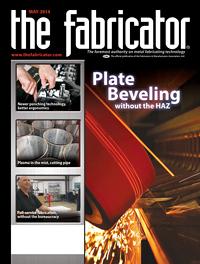Senior Editor
- FMA
- The Fabricator
- FABTECH
- Canadian Metalworking
Categories
- Additive Manufacturing
- Aluminum Welding
- Arc Welding
- Assembly and Joining
- Automation and Robotics
- Bending and Forming
- Consumables
- Cutting and Weld Prep
- Electric Vehicles
- En Español
- Finishing
- Hydroforming
- Laser Cutting
- Laser Welding
- Machining
- Manufacturing Software
- Materials Handling
- Metals/Materials
- Oxyfuel Cutting
- Plasma Cutting
- Power Tools
- Punching and Other Holemaking
- Roll Forming
- Safety
- Sawing
- Shearing
- Shop Management
- Testing and Measuring
- Tube and Pipe Fabrication
- Tube and Pipe Production
- Waterjet Cutting
Industry Directory
Webcasts
Podcasts
FAB 40
Advertise
Subscribe
Account Login
Search
Hitting print: The future of additive manufacturing
How our great-grandchildren may make things
- By Tim Heston
- May 14, 2014
- Article
- Additive Manufacturing
In May 1974 a front-page headline graced the then fledgling FABRICATOR—“LASER METAL CUTTING: The use of lasers in metal fabrication.” The depicted machine, a retrofitted oxyfuel system, was only 500 watts, but it could handle thin gauges fairly well. Still, so could punch presses. And still older technology, stamping presses, could blank out profiles in one hit, while the low-powered laser behemoth lumbered along the part profile. Yes, you eliminate hard tooling, but look how slow it was cutting. How could this possibly take off? We know what ultimately happened.
Today you can see additive manufacturing at work, be it 3-D printing of plastics or (just recently) carbon fiber, or direct metal fabrication, using lasers or electron beam welding technology to build a part layer by layer. From a throughput perspective, additive manufacturing isn’t jaw-dropping yet. But from a designer’s perspective, additive manufacturing is a true game-changer. How amazing to be able to design a part on the desktop and then print a plastic version of it.
This takes rapid prototyping to a whole new level, but additive manufacturing is moving beyond the prototype arena. Parts that once were machined from expensive material are now built up layer by layer for use in low-volume products. For instance, “GE Reports,” a newsletter of GE Aviation, described how the company is aiming “to build the world’s first passenger jet with 3-D printed nozzles, including heat-resistant ceramic matrix composites.”
There’s no shortage of crystal ball statements about additive manufacturing, and one of the most common has to do with how wasteful subtractive manufacturing processes are. From a purely time perspective, additive manufacturing machines could simplify production planning. If you know the machine cycle time, you basically know a good portion of the overall manufacturing time, start to finish.
If those parts go into an assembly, workers could pull parts as needed and trigger additive manufacturing machines upstream to start producing more parts, all carefully timed to an ideal takt for that part. Making things to stock would just seem quaint, and the single-piece part flow of lean manufacturing would seem utterly natural.
The cost of some of these new printing systems isn’t out of this world. Waltham, Mass.-based MarkForg3D’s carbon fiber printer retails for less than $5,000 (www.markforg3d.com). As CEO Greg Mark, the inventor of the technology, put it in a recent web video, “As long as either you can design a part, or you have access to somebody who can design a part, you hit print, and you have the part.”
Considering this, why have a place for manufacturing at all? As Richard A. D’Aveni put it in the Harvard Business Review last year: “As applications of the technology expand and prices drop, the first big implication is that more goods will be manufactured at or close to their point of purchase or consumption. This might even mean household-level production of some things … Short of that, many goods that have relied on the scale efficiencies of large, centralized plants will be produced locally.”
How all this really plays out is anyone’s guess, but no one can deny that the art and science of making things is changing. Say two competing fabricators have identical machines—same brand, same make, same age. Both fabricators also use highly advanced software that digitizes information flow from the CAD desktop to the machine control. What, beyond price, differentiates these two companies in the local market?
It’s talent, of course. In the past much of this talent differentiation came from craftsmanship (for more on this, see this issue’s Improvement Insights). And this remains true for hands-on processes, most notably welding. Another differentiator is design. Manufacturing technicians can design process improvements, such as offline programming software and quick-change tooling that adapts high-product-mix production to robotic welding.
For low-volume work, fabricators can handle the entire manfacturing process, shipping directly to their customers’ customers. For higher-volume jobs, fabricators can offer design assistance in the early stages of a product launch. Still, as manufacturing technology continues to progress, barriers to manufacturability will continue to fall. A ridiculously tight tolerance today may not seem so ridiculous in a generation. Certain physical attributes of sheet metal and plate won’t change, unless the actual metal-making processes change, but when you think about “hitting print,” who says any metal alloy will be the material of choice? And why weld or assemble something if it can just be made complete in one step?
That leaves one last differentiator: timing. Good on-time-delivery performance is the baseline for this. The best laser in the world can’t perform if the operator doesn’t show up and there’s no one to take his place. On-time delivery of quality parts is the foundation of long-term survival.
But this also can relate to timing of product introductions. The most advanced manufacturing machine in the world can’t guarantee that the product it fabricates will be a success. The product’s design, intent, and market potential play a role—but so does timing, and here’s where contract fabricators today are critical.
I spoke recently with Chris Kambeitz, business development manager for BTD, a $167 million contract fabricator based in Detroit Lakes, Minn. The company sells its design-for-manufacturability services, engineering costs out of a product. But it also sells its ability to ramp up production exactly when customers need it most. This service in turn allows the fabricator to penetrate myriad markets and diversify its customer base. “We have a pretty good reputation with the leaders in certain industries,” Kambeitz said. “We help them be the first to market, which obviously helps both us and them.”
Advanced machine tools have made manufacturing easier, but they can’t predict the behavior of markets. Generations from now, when people everywhere simply may be hitting print to turn ideas into reality, making things won’t be so difficult—but determining when to hit print may mean the world.
About the Author

Tim Heston
2135 Point Blvd
Elgin, IL 60123
815-381-1314
Tim Heston, The Fabricator's senior editor, has covered the metal fabrication industry since 1998, starting his career at the American Welding Society's Welding Journal. Since then he has covered the full range of metal fabrication processes, from stamping, bending, and cutting to grinding and polishing. He joined The Fabricator's staff in October 2007.
subscribe now

The Fabricator is North America's leading magazine for the metal forming and fabricating industry. The magazine delivers the news, technical articles, and case histories that enable fabricators to do their jobs more efficiently. The Fabricator has served the industry since 1970.
start your free subscription- Stay connected from anywhere

Easily access valuable industry resources now with full access to the digital edition of The Fabricator.

Easily access valuable industry resources now with full access to the digital edition of The Welder.

Easily access valuable industry resources now with full access to the digital edition of The Tube and Pipe Journal.
- Podcasting
- Podcast:
- The Fabricator Podcast
- Published:
- 04/16/2024
- Running Time:
- 63:29
In this episode of The Fabricator Podcast, Caleb Chamberlain, co-founder and CEO of OSH Cut, discusses his company’s...
- Trending Articles
AI, machine learning, and the future of metal fabrication

Employee ownership: The best way to ensure engagement

Steel industry reacts to Nucor’s new weekly published HRC price

Dynamic Metal blossoms with each passing year

Metal fabrication management: A guide for new supervisors

- Industry Events
16th Annual Safety Conference
- April 30 - May 1, 2024
- Elgin,
Pipe and Tube Conference
- May 21 - 22, 2024
- Omaha, NE
World-Class Roll Forming Workshop
- June 5 - 6, 2024
- Louisville, KY
Advanced Laser Application Workshop
- June 25 - 27, 2024
- Novi, MI



























